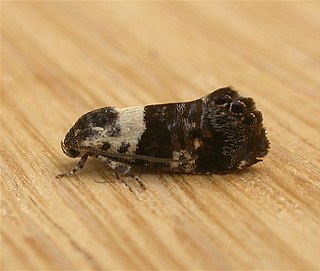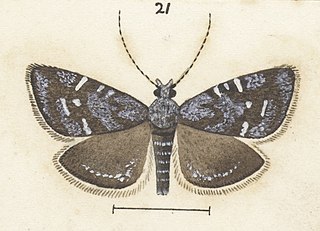
Eupselia aristonica is a species of moth of the family Depressariidae. It is found in Australia, where it has been recorded from New South Wales, the Australian Capital Territory, Victoria and Tasmania.

Mesapamea secalis, the common rustic, is a moth of the family Noctuidae. The species was first described by Carl Linnaeus in his 1758 10th edition of Systema Naturae. It is found in Europe, north-west Africa, Turkey and northern Iran.
Trichoptilus scythrodes is a moth of the family Pterophoridae that can be found in Australia, including New South Wales and South Australia.

Phyllonorycter heegeriella is a moth of the family Gracillariidae. It is found in all of Europe, except the Iberian Peninsula and the Balkan Peninsula.

Asterivora symbolaea is a species of moth in the family Choreutidae. It is endemic to New Zealand and has been observed in Arthur's Pass. This species lives in subalpine habitat. Adults of this is on the wing in January and February. Larvae are hosted by Celmisia prorepens.

Procometis is a genus of moths in the family Autostichidae.
Ardozyga desmatra is a species of moth in the family Gelechiidae. It was described by Oswald Bertram Lower in 1897. It is found in Australia, where it has been recorded from New South Wales, Victoria and South Australia.
Battaristis emissurella is a moth of the family Gelechiidae. It was described by Francis Walker in 1864. It is found in Panama, Colombia, Suriname, Guyana and Brazil.
Compsolechia incurva is a moth of the family Gelechiidae. It was described by Edward Meyrick in 1914. It is found in Guyana, Brazil and Peru.
Procometis bisulcata is a moth in the family Autostichidae. It was described by Edward Meyrick in 1890. It is found in Australia, where it has been recorded from New South Wales.
Procometis genialis is a moth in the family Autostichidae. It was described by Edward Meyrick in 1890. It is found in Australia, where it has been recorded from Queensland.
Procometis hylonoma is a moth in the family Autostichidae. It was described by Edward Meyrick in 1890. It is found in Australia, where it has been recorded from New South Wales, Victoria, and South Australia.
Procometis lipara is a moth in the family Autostichidae. It was described by Edward Meyrick in 1890. It is found in Australia, where it has been recorded from New South Wales.
Procometis monocalama is a moth in the family Autostichidae. It was described by Edward Meyrick in 1890. It is found in Australia, where it has been recorded from New South Wales.
Procometis limitata is a moth in the family Autostichidae. It was described by Edward Meyrick in 1911. It is found in South Africa.
Cryptophasa opalina is a moth in the family Xyloryctidae. It was described by Turner in 1900. It is found in Australia, where it has been recorded from the Northern Territory, Queensland and Western Australia.
Cryptophasa melanoscia is a moth in the family Xyloryctidae. It was described by Oswald Bertram Lower in 1903. It is found in Australia, where it has been recorded from Victoria.
Eclecta is a monotypic moth genus in the family Depressariidae. Its only species, Eclecta aurorella, has been found in the Australian state of New South Wales. Both the genus and species were first described by Edward Meyrick in 1883.
Eutorna eurygramma is a moth in the family Depressariidae. It was described by Edward Meyrick in 1906. It is found in Australia, where it has been recorded from Victoria, New South Wales and Tasmania.
Imma eriospila is a species of moth in the family Immidae. It was described by Edward Meyrick in 1922. It is found in Pará, Brazil.




